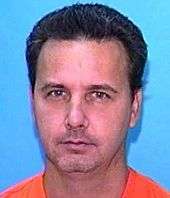Gary Ray Bowles
| Gary Ray Bowles | |
|---|---|
 | |
| Born |
January 25, 1962 Clifton Forge, Virginia |
| Criminal penalty | Death |
| Conviction(s) |
|
| Details | |
| Victims | 6-25 |
Span of crimes | 1994–1994 |
| Country | United States |
| State(s) | Florida, Georgia, Maryland |
Date apprehended | October 22, 1995 |
Gary Ray Bowles (born January 25, 1962) is an American serial killer who was sentenced to death for the murder of six men in 1994. As of April 2018, Bowles sits on Florida's death row.
Early life
Bowles was born in Clifton Forge, Virginia, and was raised in Rupert, West Virginia. His father, "Frank" who worked as a coal miner, had died from Black Lung Disease six months before, and his mother, Frances remarried several times. Bowles was abused by his second stepfather, a violent alcoholic who also abused Bowles' mother and older brother. The abuse continued until, at the age of 13, Bowles fought back and severely injured his stepfather. He left home soon after, angered by his mother's decision to remain in the marriage.[1]:2 He was homeless for the next few years, earning money as a prostitute.[1]:2
In 1982, he was arrested for beating and sexually assaulting his girlfriend, and was sentenced to six years in prison. In 1991, after his release from prison, he was convicted of unarmed robbery in the theft of an elderly woman's purse, a crime for which he was sentenced to four more years in prison; he was released in two.[2]
Murders
On April 14, 1994, in Daytona Beach, Florida, Bowles killed his first known victim, John Hardy Roberts, who had offered him a temporary place to live. Bowles beat and strangled him to death, and then stole his credit card. Police soon considered him a suspect after finding his fingerprints and probation records at the crime scene.[1]:4 Over the next six months, Bowles murdered five other men in Nassau County, Florida; Jacksonville, Florida; Savannah, Georgia; Atlanta, Georgia; and Wheaton, Montgomery County, Maryland. His typical modus operandi was to prostitute himself to his victims before beating and strangling them, and stealing their credit cards.[2] While on the run, Bowles was put on the FBI's list of the country's 10 Most Wanted Fugitives for his four known victims.[3] Finally, on October 22, 1994, Bowles was arrested for the murder of Walter Jamelle "Jay" Hinton, and confessed to all six murders.[1]
Aftermath
In May 1996, Bowles pleaded guilty to the Nov. 17, 1994, slaying of Walter Jammell Hinton in Jacksonville, who died after Bowles hit his head with a 40-pound steppingstone while Hinton was sleeping. Bowles received the death penalty for Hinton's murder.[4]
In August 1997, while sitting on death row for the slaying of Hinton, Bowles pleaded guilty to beating and strangling Roberts in 1994.[4]
Bowles was found guilty of three counts of murder and sentenced to death, but the sentence was reversed by the Florida Supreme Court, when they determined that the court erred by allowing the jury to hear that Bowles hated homosexuals and that the victim was gay.[5] He was given a new sentencing hearing, and in 1999 again received the death penalty.[6] Bowles is held in Union Correctional Institution awaiting execution.
References
- 1 2 3 4 Bell, Rachel. "Gary Ray Bowles". truTV Crime Library. Retrieved 4 April 2012.
- 1 2 "Gary Ray Bowles - murder suspect - VICAP Alert" Law Enforcement Bulletin December 1994.
- ↑ https://web.archive.org/web/20091202033351/http://www.prisonboundserialkillers.com/gary_bowles. Archived from the original on December 2, 2009. Retrieved January 25, 2010. Missing or empty
|title=(help) - 1 2 "Bowles Pleads Guilty, Gets Life For Murder Of Daytona Beach Man". orlandosentinel.com. 1997-08-07. Retrieved 2018-04-10.
- ↑ "GARY RAY BOWLES v. SECRETARY FOR THE DEPARTMENT OF CORRECTIONS FLORIDA ATTORNEY GENERAL". findlaw.com. 2010-06-18. Retrieved 2018-04-10.
- ↑ "(Unofficial Transcript of oral argument before the Florida Supreme Court) Gary Ray Bowles vs State of Florida". WFSU. Archived from the original on 28 February 2001. Retrieved 4 April 2012.